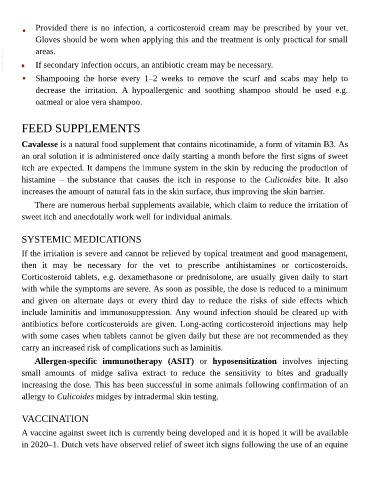Page 838 - The Veterinary Care of the Horse
P. 838
• Provided there is no infection, a corticosteroid cream may be prescribed by your vet.
Gloves should be worn when applying this and the treatment is only practical for small
VetBooks.ir • areas.
If secondary infection occurs, an antibiotic cream may be necessary.
• Shampooing the horse every 1–2 weeks to remove the scurf and scabs may help to
decrease the irritation. A hypoallergenic and soothing shampoo should be used e.g.
oatmeal or aloe vera shampoo.
FEED SUPPLEMENTS
Cavalesse is a natural food supplement that contains nicotinamide, a form of vitamin B3. As
an oral solution it is administered once daily starting a month before the first signs of sweet
itch are expected. It dampens the immune system in the skin by reducing the production of
histamine – the substance that causes the itch in response to the Culicoides bite. It also
increases the amount of natural fats in the skin surface, thus improving the skin barrier.
There are numerous herbal supplements available, which claim to reduce the irritation of
sweet itch and anecdotally work well for individual animals.
SYSTEMIC MEDICATIONS
If the irritation is severe and cannot be relieved by topical treatment and good management,
then it may be necessary for the vet to prescribe antihistamines or corticosteroids.
Corticosteroid tablets, e.g. dexamethasone or prednisolone, are usually given daily to start
with while the symptoms are severe. As soon as possible, the dose is reduced to a minimum
and given on alternate days or every third day to reduce the risks of side effects which
include laminitis and immunosuppression. Any wound infection should be cleared up with
antibiotics before corticosteroids are given. Long-acting corticosteroid injections may help
with some cases when tablets cannot be given daily but these are not recommended as they
carry an increased risk of complications such as laminitis.
Allergen-specific immunotherapy (ASIT) or hyposensitization involves injecting
small amounts of midge saliva extract to reduce the sensitivity to bites and gradually
increasing the dose. This has been successful in some animals following confirmation of an
allergy to Culicoides midges by intradermal skin testing.
VACCINATION
A vaccine against sweet itch is currently being developed and it is hoped it will be available
in 2020–1. Dutch vets have observed relief of sweet itch signs following the use of an equine

